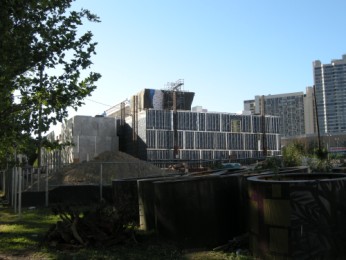The Philadelphia Inquirer threw a lot of resources at the Barnes Foundation this weekend, providing a preview as the new building in the city moves toward its opening on May 19 — I counted seven articles and six slide shows online, though I have not seen the physical paper. UPDATE: Turns out there are more than seven articles — at least 10 — now online and in print (which I have not seen).
 The paper is pretty positive about the new Barnes, which makes sense; opponents of the move from Merion to the city feel the paper and the city’s power elite who made the move a reality have always been aligned. They want to make Philadelphia an art destination, and as fine as the Philadelphia Museum of Art’s collection is, the city wasn’t a destination for art-lovers unless the museum mounted a blockbuster (which it did regularly).
The paper is pretty positive about the new Barnes, which makes sense; opponents of the move from Merion to the city feel the paper and the city’s power elite who made the move a reality have always been aligned. They want to make Philadelphia an art destination, and as fine as the Philadelphia Museum of Art’s collection is, the city wasn’t a destination for art-lovers unless the museum mounted a blockbuster (which it did regularly).
Now, when you combine the two nearby collections, the city truly does have an impressive cluster of 19th Century French works. Here’s the tally according to the Inquirer:
Add the Barnes’ 181 Renoirs to the Art Museum’s 16 and that is the largest collection in the world. The Barnes’ 69 Cezannes plus the museum’s 16 amounts to more than there are in all of France. The Barnes owns 46 Picassos; the museum, 23. The Barnes has 59 Matisses, the museum, 15. The Barnes owns 18 Rousseaus, the museum, 10. Each institution boasts seven van Goghs.
In one Inquirer article, about the city’s “Museum Mile,” Philadelphia Museum curator Joseph Rishel says the cluster will become a pilgrimage site for art-lovers. On the other hand, Witold Rybczynski, architect, author, and University of Pennsylvania professor, says “I don’t think it’s a great idea to have three museums lined up in a row or three stadiums next to each other – there’s no synergy in that” and “No one spends two hours in a museum, then goes down the street to spend two hours in another.” I think they are both right, with a qualifier on Rybczynski’s “no one.” Most people don’t go from museum to museum, but traveling art pilgrims do. The question is how many they are — and whether they care about the legitimacy of the move.
Critic Edward Sozanski called the change this way: “The metamorphosis doesn’t diminish the art, but it does significantly alter the context in which visitors encounter it…” and “It’s not an absolutely precise re-creation, although the changes for the most part enhance the viewing experience.” (One wonders, as he repeated himself, if he was trying to convince himself.)
One change he mentions is better lighting. Here’s another:
Matisse fans and art historians will be delighted to discover that the masterpiece The Joy of Life no longer languishes on a landing in a stairwell. It’s now ensconced in a small room on the second floor that in Merion was where the trustees met.
The Joy of Life, a key step in the development of modern art, is now directly juxtaposed with Matisse’s mural The Dance, which fills three lunettes in the first-floor central gallery. My memory could be playing tricks, but the mural seems to be slightly easier to see in the museum than it was in Merion, even if it does involve architectural sleight-of-hand.
Sozanski also notes that the Barnes, now a real museum, has guest amenities, like a place to buy a sandwich.
Architecture critic Inge Saffron wrote two pieces, including a straight review, and she’s not crazy about the new Barnes:
…no less urgent, is the issue of how the new ensemble fits into its new home in the city. The answer is that it doesn’t.
In a nutshell, everything wrong with the new Barnes stems from a desire to compensate for the problems of the past. Hence the huge, unnecessary parking lot. It not only blocks the view of the Barnes’ elegant entrance facade, but it also weakens the emerging hub at 20th and Callowhill Streets. The bus drop-off is comically over-scaled – like the driveway at a Merion mansion – and cursed with a canopy so tacky one can imagine it presiding over a highway gas station. Add a grotesquely large, all-too-visible loading dock, and what you get is a site that has all the aesthetic coherence of a suburban supermarket.
